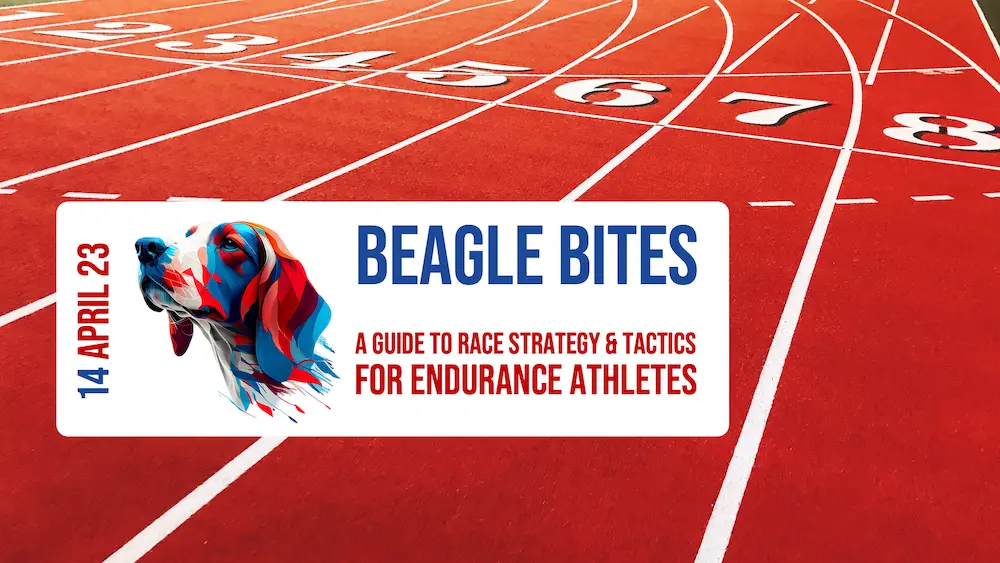Introduction
Endurance races in track and field and cross country, spanning distances from 800 meters to marathons, present a unique challenge for athletes and us as coaches. Success in these events necessitates a thorough understanding of optimal race strategies, physiological aspects, psychological factors and the impact of various race environments on performance.
This Beagle Bites aims to provide a guide for endurance athletes and coaches by drawing from recent research and expert advice. We will discuss the importance of pacing, physiological and psychological factors and the influence of race environments on performance.
Approaches
In short, there are three primary approaches to planning and implementing racing tactics in an endurance race:
- Biological approach: Treating the body as a living machine, ignoring the competition, and focusing on achieving the greatest energy system efficiency possible. This often involves even pacing throughout a long ‘comfort zone’ (using your aerobic energy system) followed by a rapid sprint through the ‘critical zone’ (your anaerobic energy systems).
- Competition-based approach: Focusing solely on the competition while disregarding biological aspects. This typically leads to a challenging ‘comfort zone’ that depletes anaerobic energy reserves, resulting in a ‘critical zone’ where the athlete merely tries to hang on and hope the competition is not too close behind.
- Combined approach: Incorporating both biological and competition-based elements, this is the most effective strategy because it balances the body’s physiological needs with the competitive aspects of the race. This method involves monitoring the competition while maintaining a well-managed ‘comfort zone’, enabling the athlete to utilise their anaerobic energy systems in the ‘critical zone’ effectively.
To do this effectively, we need to consider the different variables that must be accommodated during the race and these must be practised during training to ensure you can deploy differing tactics as required. If you want to know more here, remember to speak to your coach and they will explain the differing energy systems at work here.
Pacing Strategies
Pacing is a crucial factor in optimising performance for endurance athletes. Research has demonstrated that maintaining a consistent, evenly distributed pace throughout the race is more beneficial than adopting a highly variable pace (Abbiss & Laursen, 2008; Hanley, 2016). Even pacing allows athletes to avoid premature fatigue and make the most efficient use of their energy reserves (Foster et al., 2017).
- Positive Split: This strategy involves running the first half of the race faster than the second half. Although this approach can lead to early fatigue, some athletes may prefer it to gain a competitive advantage early in the race (Hanley, 2016). However, research suggests that this strategy is less effective than even or negative split pacing (Lima-Silva et al., 2010).
- Negative Split: Running the second half of the race faster than the first half allows athletes to conserve energy and finish strong (Foster et al., 2017). This strategy is particularly effective for experienced runners who are adept at controlling their effort and pacing (Lima-Silva et al., 2010).
- Even Pacing: Research has shown that even pacing yields optimal performance in endurance races (Abbiss & Laursen, 2008; Hanley, 2016). Runners should aim to maintain a steady, consistent pace throughout the race, avoiding surges that may lead to premature fatigue.
Physiological and Psychological Factors
- VO2max and Lactate Threshold: A runner’s maximum oxygen consumption (VO2max) and lactate threshold play crucial roles in determining race performance (Bassett & Howley, 2000; Midgley et al., 2007). As coaches, we will work with athletes to focus on improving these key physiological markers to enhance performance.
- Mental Toughness: Psychological factors, such as mental toughness, have been linked to improved race performance (Crust & Clough, 2011). Techniques such as visualisation, goal setting, and self-talk can help athletes cultivate mental toughness and maintain focus during competition (Weinberg & Gould, 2014).
- Coping with Pain: Dealing with pain and discomfort during distance races is an essential skill for runners. Research has shown that mindfulness-based interventions can help athletes cope with pain and improve their overall performance (Baltzell & Akhtar, 2014).
Race Environment
- Weather Conditions: Adverse weather conditions, such as heat, humidity, and wind, can significantly impact race performance (Ely et al., 2007; Montain et al., 2007). Runners should be prepared to adjust their pacing strategies and hydration plans to account for these factors.
- Altitude: Racing at high altitudes can lead to reduced oxygen availability and increased physiological strain (Chapman & Levine, 2007). High-performance athletes should acclimatise to altitude before competition and adjust their pacing strategies accordingly (Fulco et al., 1998).
- Terrain: The type of terrain and course profile can influence race strategy and tactics. Runners should consider factors such as hills, uneven surfaces, and tight turns when planning their race approach (Tucker et al., 2006).
Tactical Considerations
- Drafting: Running directly behind another competitor can reduce air resistance and conserve energy. This tactic, known as drafting, has been shown to improve race performance in endurance running events (Pugh, 1971; Jones & Doust, 1999).
- Positioning: Maintaining a strategic position in a race can be important to success. Runners should aim to stay near the front of the pack to avoid being boxed in and to capitalise on opportunities to break away or respond to surges (Cottin et al., 2004).
- Surging: Surging, or temporarily increasing pace, can be an effective tactic for breaking away from competitors or testing their response (Hanley, 2016). However, runners must be mindful of their energy reserves and avoid overexerting themselves during surges.
Conclusion
Developing a well-rounded race strategy and mastering the tactics discussed in this Beagle Bites can significantly improve the performance of endurance athletes in their pursuit of podiums. If you want to know more, discuss this with your coach at a training session or reach out via our coaching page.
Further reading: England Athletics Guidance – Youth Endurance



